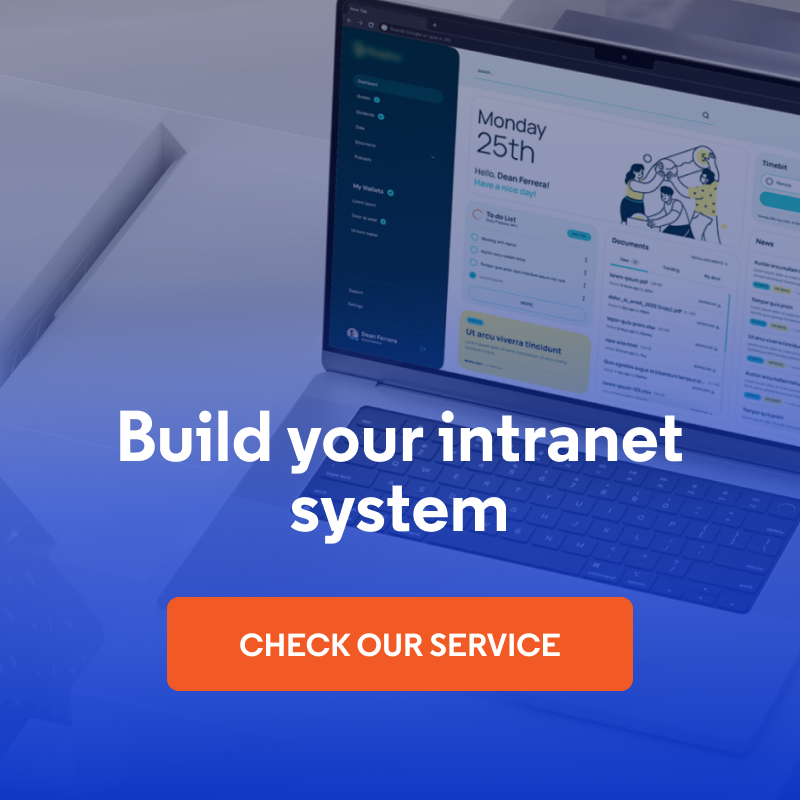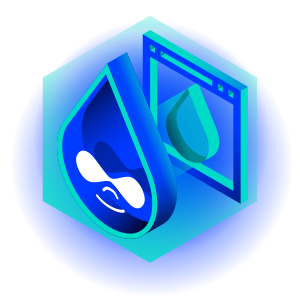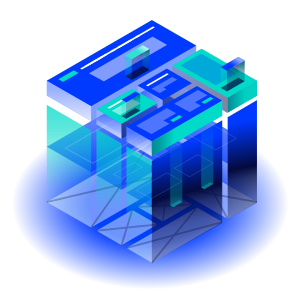
How to Solve Internal Communication Issues in a Company with Open Intranet?
Efficient internal communication is the foundation of any organization's effective work. Without it, there is chaos, frustration, and decreased productivity. In the article, I will present 13 of the most common internal communication issues in companies and show how to solve them effectively using Open Intranet, a Drupal-based system. In the article, I use information from my video, which you can see on the Nowoczesny Drupal channel.
In this article:
- The most common internal communication issues in the company
- 1. Loss of knowledge due to employee turnover
- 2. Time-consuming onboarding process
- 3. Repeated questions to HR and IT departments
- 4. No ticket system for departments
- 5. Difficult access to documents and procedures
- 6. Knowledge isolation among employees
- 7. Communication silos between departments
- 8. Tool chaos
- 9. Too many communication tools
- 10. A lack of communication channels for some employees
- 11. No common calendar of events
- 12. Lack of control over access to data
- 13. No access to current internal contacts
- Open Intranet - basic information
- Key features of Open Intranet for employee communications
- Company intranet - a key to effective internal communications
The most common internal communication issues in the company
We have conducted a detailed analysis of internal communication challenges reported by our clients who are interested in implementing intranet software. Our study is based on data obtained from about 40 companies. The information came from inquiries, briefs, and direct conversations. As a result, we selected 13 problems that recurred most frequently and had the most negative impact on the operation of these organizations.
In the first part of this article, I will discuss these difficulties, and in the second part, I will show how to deal with them using the Open Intranet system—a ready-made, flexible intranet solution based on the popular Drupal content management system.
1. Loss of knowledge due to employee turnover
An employee who leaves a company often takes with him or her key knowledge of the execution of duties, especially when the scope of work for his or her position is not clearly described and procedures, instructions, or notes are not written down. As a result, a new person hired for the same position has to discover all responsibilities and processes from scratch, which is time-consuming and costly for the company. The lack of knowledge documentation causes the company to unnecessarily waste both time and financial resources.
Solution in Open Intranet: a knowledge base. There you can collect instructions, procedures, and documents that will facilitate a smooth transition of responsibilities to the next person.
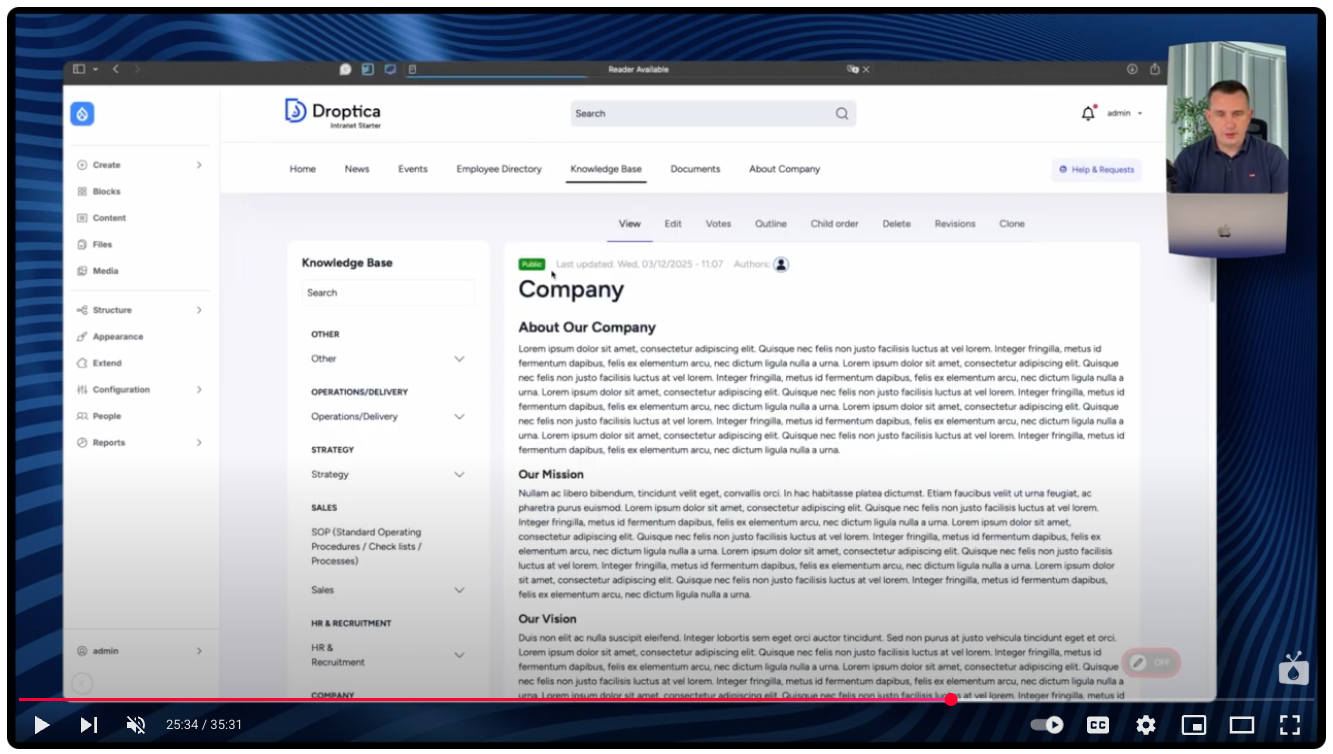
2. Time-consuming onboarding process
A new employee needs time to learn the specifics of how a company operates. Even if they have previously held a similar role in another organization, each company has its own unique working methods that a new employee needs to learn. If onboarding relies only on general guidance, the process can become chaotic and prolonged. Without well-prepared training materials, detailed instructions, and descriptions of procedures, a new employee often feels lost and must often guess or ask questions, putting additional strain on other team members. The result of this approach is a delay in the new employee's moment of full productivity and greater costs to the company.
Solution in Open Intranet: knowledge base. Our intranet software allows you to create structured onboarding materials in a knowledge base, so that every employee can quickly achieve high productivity.
3. Repeated questions to HR and IT departments
Employees often ask IT or human resources departments the same questions related to vacations, password resets, or remote work. Each question, while brief from an employee's perspective, can come up dozens of times a month, straining these departments' resources.
Solution in Open Intranet: a knowledge base. Creating a central FAQ database, where answers to recurring questions are readily available, will allow employees to quickly find the information they need and support departments to save time for more important tasks.
4. No ticket system for departments
Solution in Open Intranet: a ticket system. Such functionality allows you to organize the process of taking over and handling notifications, allows you to analyze them and monitor their statuses, which significantly enhaces communication and operation of the entire organization.
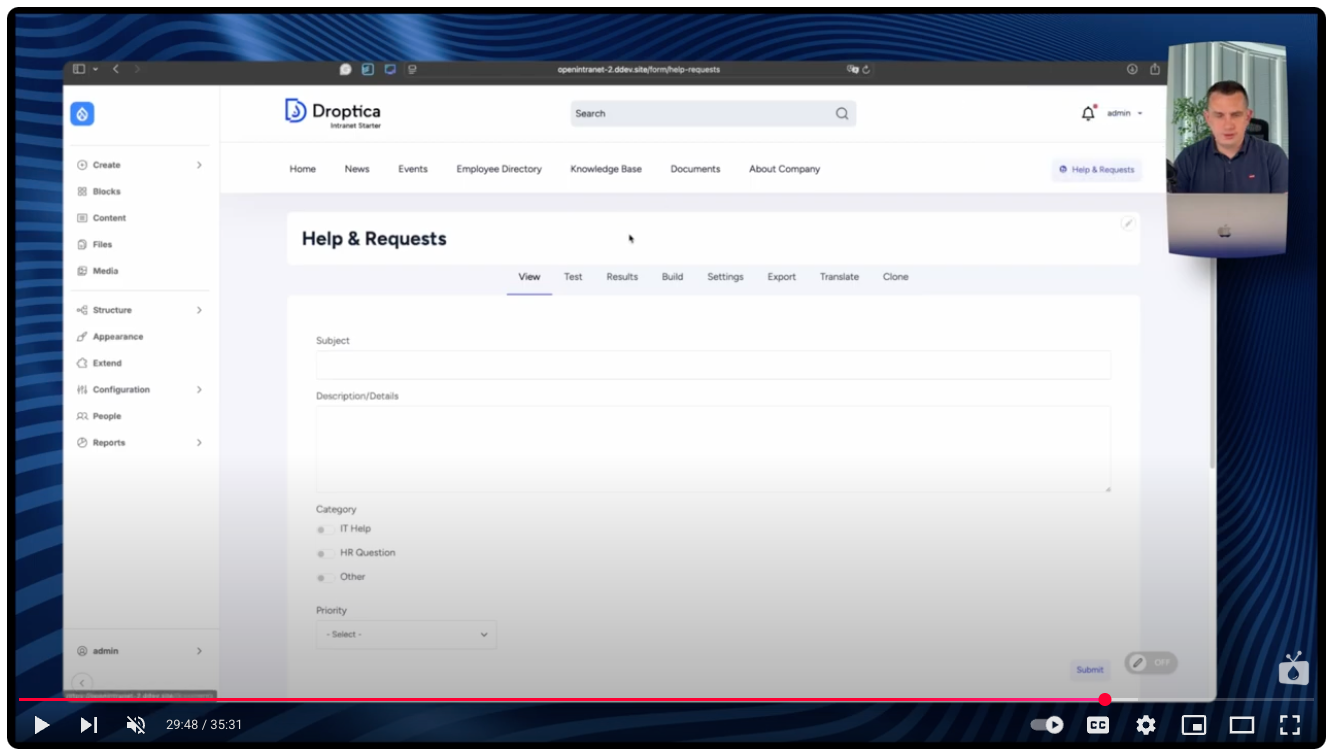
5. Difficult access to documents and procedures
In many companies, documents and procedures are scattered in different places - the marketing department uses Google Drive, the sales department stores files in Notion, and production saves instructions on a local network drive. Often, where documents are stored depends on individual employee preferences, leading to a situation where some documents are only on emails or instant messengers such as Slack. As a result, employees access needed documents with difficulty, often wasting time by asking others instead of retrieving them from a central source. It is also common for employees to use old, outdated versions of documents, leading to errors and inefficiency.
Solution in Open Intranet: a central place to store documents. It enables quick search, version control and precise access management, eliminating chaos and improving work efficiency.
Read also: Key Points to Consider When Planning a New Intranet for Your Business
6. Knowledge isolation among employees
7. Communication silos between departments
Different departments or divisions within a company often operate like separate entities, with their own data, systems, and procedures, without working together effectively. An example would be a situation where the sales department is unaware of marketing activities, or headquarters is unaware of what is happening in regional branches. Such a lack of cooperation results in duplication of work, loss of valuable information, and prolonged decision-making and task completion.
Solution: an entire Open Intranet. In this case, the implementation of a single, company-wide common intranet software will improve interdepartmental communication, collaboration, and knowledge sharing.
8. Tool chaos
In many companies, there is tool chaos - different departments use different applications and systems. This situation results in the need to set up multiple user accounts, remember numerous passwords, and frequently switch between applications. The result is frustrated employees, slower work, and disorganized data.
Solution: an entire Open Intranet. One central tool that integrates multiple functions streamlines work, reduces the need for multiple applications, and provides transparency of information.
9. Too many communication tools
Companies often use multiple channels - emails, instant messaging, and social media platforms. Because of this, key information—such as new procedures, training, or important changes—fails to reach employees. Each employee has his or her own preferences and habits regarding the use of communication tools, which leads to situations where important messages are overlooked or ignored.
Solution in Open Intranet: one main communication channel in the form of company news, making important information easily accessible to all.
10. A lack of communication channels for some employees
Field, shift, or production employees often do not have adequate access to company news because they do not work at desks or computers. The lack of appropriate channels excludes them from the internal information flow, which lowers their sense of self-worth and work efficiency.
Solution in Open Intranet: access to the intranet from mobile devices and special sections available for all types of employees, ensuring that relevant documents and information are available regardless of location or type of work.
11. No common calendar of events
The lack of a central location for information about company events, trainings, and meetings means that many employees find out about them too late or not at all. This results in low employee engagement and frustration for organizers.
Solution in Open Intranet: a central calendar of company events, easily accessible to every employee.
12. Lack of control over access to data
Companies often lack clear rules governing access to information. Documents, procedures, or other key data are available to everyone, or conversely, it is unclear who actually has access to them. As a result, employees can see information that is not intended for them, and sometimes even former employees still have access to confidential data. This situation increases the risk of information leaking outside the organization and reduces overall trust in company systems. The lack of clear rules also leads to a situation where employees avoid official internal communications channels by sending files through informal channels, which generates additional chaos and a sense of insecurity.
Solution in Open Intranet: a permission management system that precisely controls who has access to particular documents and information.
13. No access to current internal contacts
In many organizations, it is difficult to quickly find contact information for a specific person or to see who works in a particular department or division. Employees have to ask others, sift through emails, or try their luck by calling random people. This method of internal communication is inefficient and frustrating - it wastes time, delays tasks, and increases miscommunications. New employees additionally feel lost, not knowing who to turn to with a specific question. As a result, although the team theoretically exists, in practice, it is difficult to communicate with them.
Open Intranet solution: an employee directory filterable by department, location, and position, with up-to-date contact information for all your employees.
Open Intranet - basic information
Open Intranet is a ready-to-implement, flexible intranet software based on Drupal that effectively solves all the internal communication challenges described earlier. The tool we created is available free of charge. All you need to do is visit the Open Intranet installation tab on droptica.com and download this tool using the available installation command.
Easy installation
Installing Open Intranet is simple and fast. All you need is the DDEV tool, which allows you to get your Drupal environment up and running quickly.
- Before starting the installation, make sure that DDEV is properly installed - detailed instructions are on the project website.
- Then, you copy the installation command, paste it into the terminal, and wait for the system to download all the necessary Drupal modules and configurations.
- After the download is complete, you will be asked to remove any developer files.
- The last step is to type the "DDEV launch" command, which will launch a simple installer, where you can fill in the basic installation data and decide whether you want to install sample content. We recommend that you install the sample content during the first launch so that you can more easily familiarize yourself with the system's capabilities.
Key features of Open Intranet for employee communications
Open Intranet is equipped with a number of key features that effectively solve the internal communication challenges mentioned earlier. We will arrange the most important ones below.
News
The home page of the intranet always shows the latest information, such as announcements, changes in procedures, employee achievements, or important company events. Each entry can include a photo, date, title, and a short description. Users are able to comment on and like news items, which promotes greater interaction and employee engagement. There is also a full history of all entries in the News section, where archived news can be easily viewed using intuitive paging.
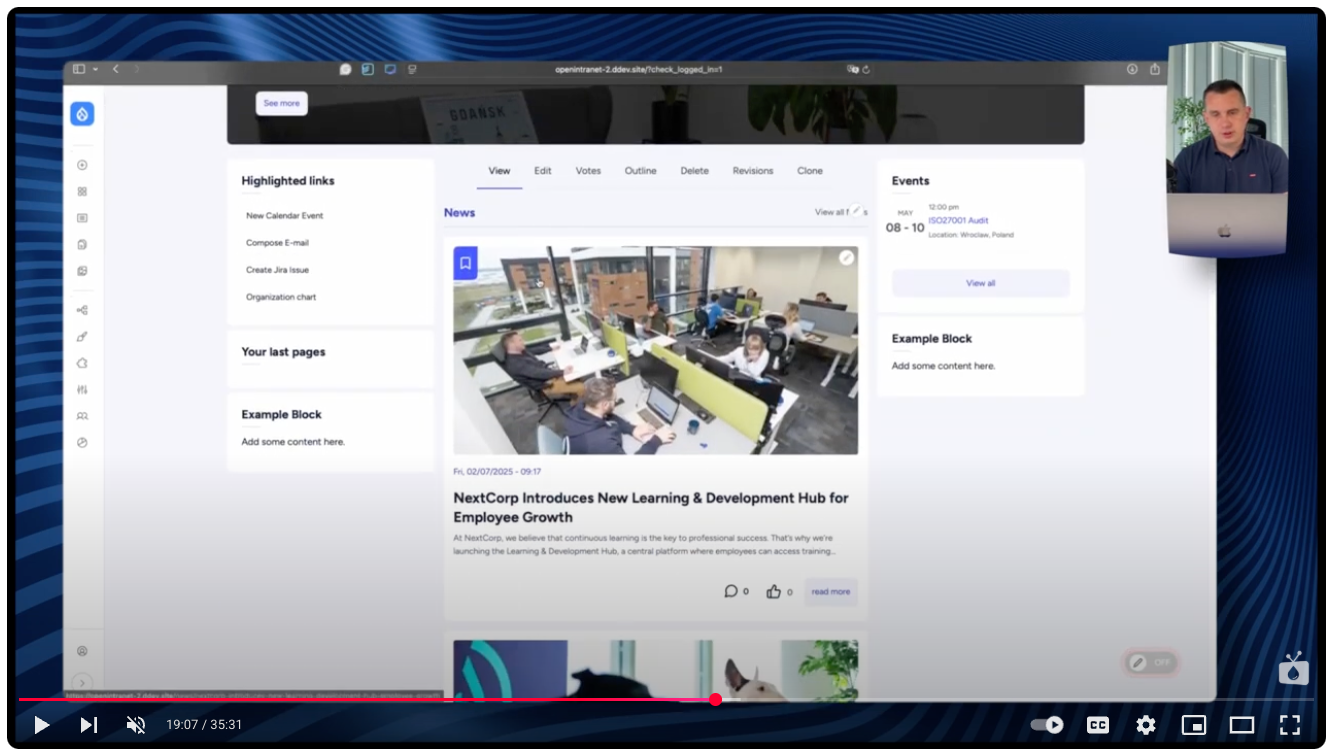
When you add a new entry, you can tag it with specific tags that make it easy to later search and filter information by category, such as company events or procedure updates. Optionally, related documents can also be added, which is useful, for example, when new forms or instructions are introduced. In addition, more important news items can be pinned to the top of the list so that they are easily seen by all employees.
Calendar
The calendar in Open Intranet is available both from the main menu and as an abbreviated list of upcoming events on the home page. Employees can view upcoming team meetings, trainings, or important dates in a monthly or weekly calendar view. Adding a new event is done using a simple form - just enter a title, description, start and end date, and - optionally - location and graphics. This allows each event to be described in detail and easily identified by participants.
Employee directory
Open Intranet's employee directory is a convenient tool for quickly finding someone working in a company. It is based on user accounts from Drupal, which means that each person with access to the intranet has a business card containing his or her name, position, department, office, and contact information.
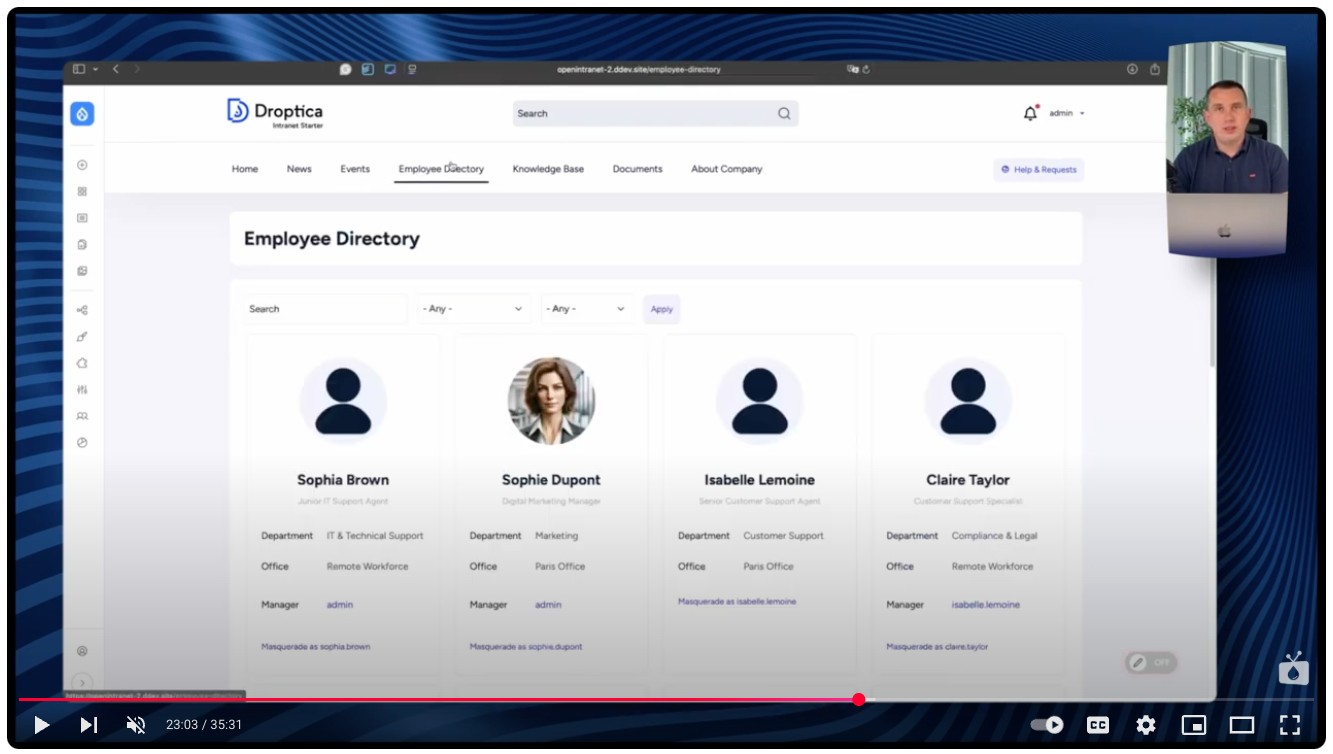
The directory can be searched and filtered by various criteria - first name, last name, department, or office location, which significantly reduces the time it takes to find the right contact. When you click on an employee's profile, you can immediately see their contact information and contact them by email or phone.
Access management
Open Intranet offers advanced access management to content thanks to its built-in permission assignment feature. Each entry—whether a news item, event, document, or knowledge base page—can have specific access restrictions, depending on the department, office, or specific user group.
Administrators can easily set that a given material will be visible only to HR professionals or, for example, only to employees of the Madrid branch. This access is defined by assigning appropriate tags and taxonomies to the user profile and to the content. In this way, the system takes care of the confidentiality of information, reduces the risk of accidentally sharing data with unauthorized people and ensures that employees have access only to content that is relevant to them.
Knowledge base
Open Intranet's knowledge base is based on Drupal's Book module, which allows you to create a structured content structure divided into departments, such as HR, marketing, sales, or production. Each department can contain its own subpages, which can be freely developed and nested in the structure. Adding new pages is done intuitively - just click add a subpage, fill in the content, and save. This makes it possible to build extensive, logically arranged internal documentation.
The knowledge base also includes features such as:
- global search engine,
- list of authors editing content,
- history of change
- option to clone existing pages.
Such a system is great for organizing onboarding content, procedures, checklists, or answers to frequently asked questions - this way, knowledge in the company ceases to be scattered and gains real value for all employees.
Documents
One of the key features of Open Intranet is the central management of company documents. The intranet software allows you to conveniently store, search, and filter files by department, subject, or document type. Each file can be assigned to a specific business area, described, version-tagged, and linked to other documents.
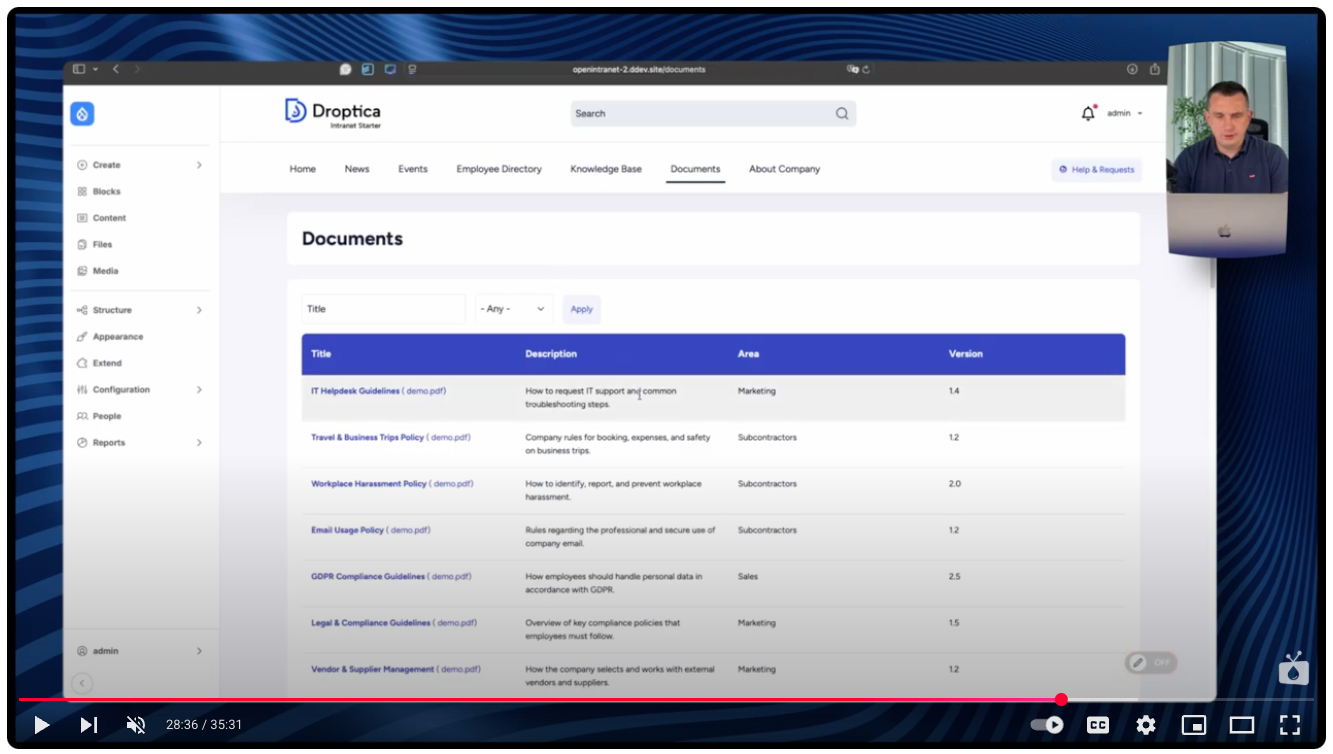
In addition, each document can be set to be accessed only by selected groups of users, guaranteeing data security and order in information circulation. Thanks to this feature, the problems of finding the right versions of documents disappear, and employees gain an orderly digital workplace with company files.
Applications
It is a central place to report and handle a variety of technical and organizational problems and needs. Open Intranet offers a simple, customizable ticket form that employees can use, for example, to report equipment failures, the need for access to tools, or other company matters.
The form can be easily customized - add new fields, assign requests to appropriate departments (e.g. IT, administration), set rules for redirection to specific systems or email addresses. This ensures that each request goes exactly where it needs to go.
The system is based on the Webform module, which allows you to create many different forms depending on your company's specifics. All requests can be tracked, their status analyzed, response time measured, and recurring problems identified, which significantly improves the organization of work and the quality of internal support.
Links to tools
This is a convenient place on the home page of the intranet where you can include links to the most frequently used applications and systems, both internal and external. For example, if a company uses Jira, CRM, or other customer relationship and project management tools, this is where you can put quick links to these systems. This section can be fully editable - administrators can add new links, delete old ones, and organize them into separate blocks or categories. With this approach, Open Intranet becomes the main point of access to all relevant tools, helping to reduce arbitrariness in the applications used and supporting consistent and efficient teamwork across the organization.
Easy expansion and integration
Open Intranet is based entirely on Drupal, a popular and flexible open source content management system. As a result, it can be freely expanded with additional modules, functionalities, and integrations, according to your company's individual needs. All manuals available for Drupal also work in this system, which means that if you ever need to change something in the configuration or add a new solution, just look for ready-made tutorials or ask a question, for example, in GPT chat.
Open Intranet is not a closed system - it is a solution built on the foundation of well-known and proven software, which can be developed both independently and with the help of the Droptica team. You can add features such as collecting ideas from employees, kudos, equipment records, a system for booking rooms, time records, a discussion forum, or an announcement section.
Extensive integrations with external tools are also possible. For example, you can upload data from Jira, Asana or Trello to the intranet and display tasks assigned to an employee. It's also possible to integrate the intranet software with instant messaging - if someone posts a news item on the platform, it will automatically appear on Slack or Microsoft Teams.
Company intranet - a key to effective internal communications
Effective communication is crucial to the efficient operation of an organization. Open Intranet, with its comprehensive set of features, allows you to solve most of the typical internal communication challenges in companies, improving transparency, efficiency, and security of information sharing.
If you are considering implementing your first intranet system or upgrading an existing solution, our team can help you at every stage of the project - from conceptualization and design of the relevant features, through programming work, to implementation and continued maintenance and development.

